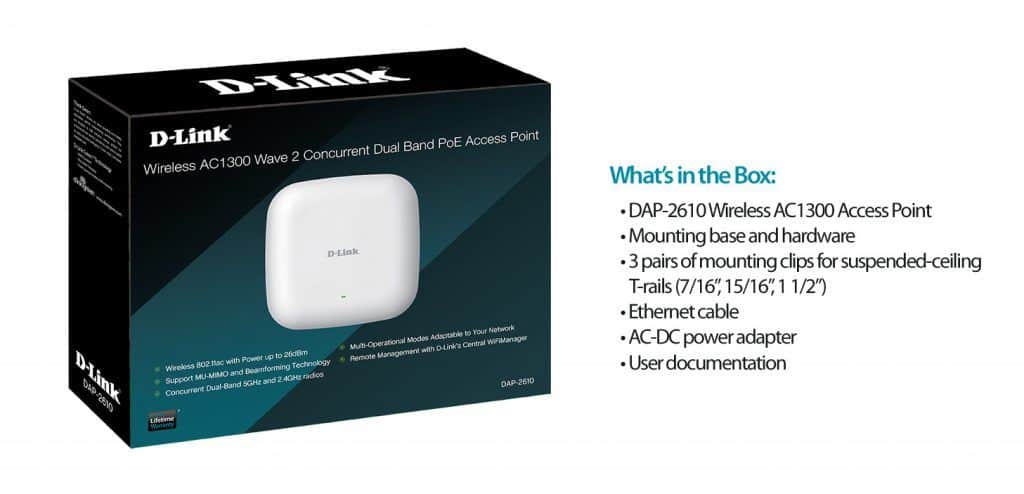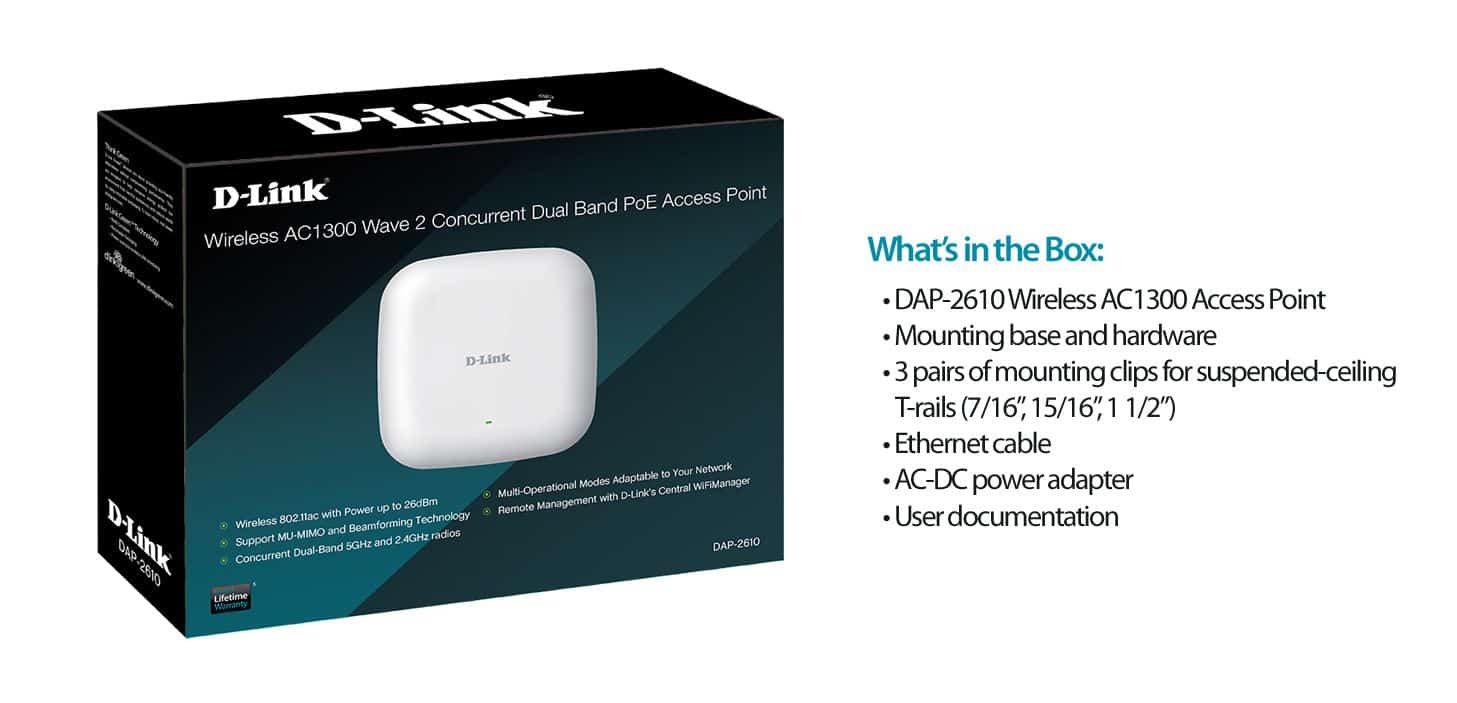amazon D-Link DAP-2610 reviews
Basically, the D-Link DAP-2610 is an extended version of the DAP-2230 device that has been tested by Biareview.
The so-called upgrade is because compared to the ‘junior’ DAP-2230, this AP model is enhanced by D-Link’s ability to expand Wi-Fi waves on the dual-band 2.4GHz and 5GHz bands at full speed up to 1,300Mbps, supporting 802.11ac as well as some advanced Wi-Fi technologies, promises to meet the needs of expanding large Wi-Fi networks for offices, large spaces , ..
As for looks, Biareview can confirm that the DAP-2610 is identical to the DAP-2230 except for a slightly larger size. This AP model is also designed with the bottom side extending as the source port (via adapter) and LAN port.
The DAP-2610 also supports power over the LAN port through PoE (Power over Ethernet) feature, allowing users to have multiple installation options.
This product is also fully equipped with accessories for wall mounting.
D-Link representative said that because it was designed for hotels, restaurants, cafes or crowded places, DAP-2610 is equipped with a series of advanced Wi-Fi technologies such as MU-MIMO; Beamforming or Band Steering …, which is only available on expensive routers.
More specifically, with Wi-Fi MU-MIMO technology, this technology inherits from the new Wi-Fi 802.11ac standard, allowing many users to perform many other activities on multiple devices at the same time points without much impact on system performance.
Meanwhile, Beamforming is a unique feature of 802.11ac that directs signals directly to designated wireless devices instead of randomly broadcasting in all directions. Therefore, this signal will be used more effectively, while increasing Wi-Fi coverage and speed.
And Band Steering will automatically switch between bands, depending on the support of the user device to optimize bandwidth.
And yet, another strong point on the DAP-2610 can operate in 4 different modes including: Access Point, Wireless Distribution System WDS with AP, and Wireless Client, allowing this device to adapt to every need to deploy wireless networks at home, office or business.
For example, with Access Point (AP) mode, the DAP-2610 can connect to any device compatible with 802.11b / g / n. Meanwhile, the WDS with AP mode is capable of expanding coverage without using a network cable, similar to the Repeater feature on some router or AP models. With Wireless Client mode, DAP-2610 will act as a Wi-Fi tuner and Internet access for 10/100 standard Ethernet ports.
In addition, this AP model is equipped with Captive Portal feature, which allows administrators to create a password authentication method to access the Internet via a web interface after connecting to an open Wi-Fi network. In this way, each end user will be provided with a unique code for one-time use of the service, while also helping administrators to not worry about changing passwords like tradition.
Two options for network management
Like most network devices for corporate customers, the D-Link DAP-2610 is also “hard-coded” by an manufacturer – namely 192.168.0.50 – for ease of installation, administative.
Detailed information about this hard IP address is specified in the accompanying documentation, so users can be assured when installing the device – especially those who are not tech-savvy.
Regarding the administration, similar to the junior DAP-2230, this AP model is also divided into 2 types of management: directly on the web platform interface and through Central WiFiManager tool.
where can you get a D-Link DAP-2610 online
D-Link DAP-2610 Wireless AC1300 Wave 2 Dual-Band PoE Access Point: Buy it now
D-Link DAP-2610 Wireless AC1300 Wave 2 Dual-Band Access Point: Buy it now
Remote management with D-Link Central WiFiManager
As Biareview introduced on DAP-2230, the DAP-2610 model is also integrated by D-Link Central WiFiManager (CWM) remote management.
Technically, this is a network infrastructure management solution, allowing administrators to easily manage multiple AP devices on different network systems without losing the initial investment costs. Just install the CWM toolkit, users will be easier to extend the available wireless network whenever the software detects that the access point (AP) is connected.
As noted by Biareview, until now, CWM still has no automation, instead, users still have to manually install Central WiFiManager software and module for DAP-2610 (similar drivers on Windows) as well as accompanying documentation. This is definitely a bit difficult for first time users.
Through practical experience, the CWM tool for DAP-2610 has almost no change in terms of built-in features. For example, the administrator can perform basic operations such as creating 7 SSIDs other than name, password, encryption standard, or enabling Bandwith optimization …
Fully supported Web platform for administrators
For direct web-based management, administrators can perform more customizations than Central WiFiManager.
Accordingly, in addition to the basic features of Wi-Fi network configuration, the DAP-2610 supports a number of advanced features such as MAC address filtering (MAC Filter), Bandwidth optimization, Schedule (allocation time management) SSID, disable SSID Broadcast mode to restrict other devices from accessing the local network.
To manage the bandwidth above from a specific SSID, go to Advanced Settings> Bandwidth optimization. Here, fill in the parameters corresponding to the speed you want to set on each SSID. Then click Add to add to the Bandwidth optimization Rules list, select Save, and finally access the Configuration> Save and Activate tab.
With schedule time, DAP-2610 allows users to arbitrarily set the Internet access time for each SSID, helping to control Internet access of individual areas within coverage. This AP’s waves will become simpler and more convenient.
Besides, DAP-2610 also integrates some features for professional users such as VLAN, RF optimization, Wireless resource (similar Roamming feature on Wi-Fi router and AP lines) or SNMP for configuration and manage access points.
Notably, with the RF optimization feature, DAP-2610 will automatically allocate waves in case the nearest device in the system has problems. This helps minimize the loss of performance in a certain area.

